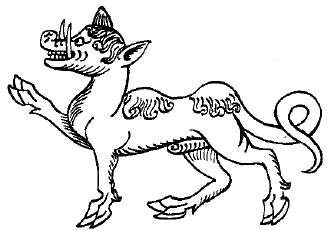Main Page: Difference between revisions
m (New pages of the month) |
(Updated page of the month) |
||
| Line 35: | Line 35: | ||
</tr> |
</tr> |
||
<tr valign="top"><td style="background-color: #f8ffff; border: 2px solid #e2ffff; border-top: none; padding: 0.6em; padding-top: none;"> |
<tr valign="top"><td style="background-color: #f8ffff; border: 2px solid #e2ffff; border-top: none; padding: 0.6em; padding-top: none;"> |
||
'''[[Bestiary]]''': A '''bestiary''' is a collection of short descriptions about all sorts of birds, beasts and [[animal]]s, both real and [[mythology|imaginary]]. Often bestiary is too narrow a description, and the [[medieval]] term "natural history" is more apt as [[gemstone|stones]], minerals, [[herb]]s and trees might also be studied, especially in later periods. The bestiary became a popular form in [[England]] in the [[12th Century]]. One example of the late medieval version of a bestiary is [[John_Maplet]]'s [[A_Greene_Forest]]. <small> ... [[Bestiary|[more]]]</small> |
|||
'''[[Becoming king]]''': The usual way to become [[king]] in the [[SCA]] is to win a [[crown tournament]]. A less common way to become king is to be the [[consort]] of a fighter who wins crown tournament. As a method for choosing a king, it has a number of advantages. The main one is that in order to be good enough to win a crown tournament, it is likely that the victor will have been involved in the SCA for a respectable amount of time. |
|||
Surprisingly, one of the arguments that is sometimes promulgated for the crown tournament model of selecting [[King]]s and [[Queen]]s is that becoming King by [[right of arms]] is period. Certainly, it is true that many [[King]]s were crowned after having conquered a Kingdom, but none became King by winning a tourney. There are however a variety of other ways people became king in period, including election.<small> ... [[Becoming king|[more]]]</small> |
|||
</td> |
</td> |
||
<td></td> |
<td></td> |
||
<td style="background: #fff3ff; border: 2px solid #ffddff; border-top: none; padding: 0.6em; padding-top: none;"> |
<td style="background: #fff3ff; border: 2px solid #ffddff; border-top: none; padding: 0.6em; padding-top: none;"> |
||
[[Image: |
[[Image:Ypotryll.gif|right]] |
||
'''Heraldic jargon: ''': |
'''Heraldic jargon: ''': An [[ypotryll]] is a [[mythology|mythical]] [[heraldic beast]] with the head of a [[boar]], the body of a [[camel]], feet of a [[goat]], and the tail of a [[snake]]. |
||
'''Dance:''' [[ |
'''Dance:''' [[Drive the cold winter away]] |
||
'''Fibre arts:''' [[ |
'''Fibre arts:''' [[Icelandic embroidery]] |
||
'''Recipe:''' [[ |
'''Recipe:''' [[Hebolas (recipe)|Hebolas]] |
||
<small>[[Cunnan:Page of the Month|More details on the Page of the Month.]]</small> |
<small>[[Cunnan:Page of the Month|More details on the Page of the Month.]]</small> |
||
Revision as of 22:03, 1 March 2006
Welcome to Cunnan, a Wiki collecting information for re-enactors of the Middle Ages and Renaissance with a heavy slant towards members of the SCA.
Cunnan is the largest SCA wiki in the world - anyone can edit our articles. You should be bold in updating pages! Articles can only be improved if people are contributing new information and improving old information. So add research information, how-to pages, event information and anything else you can think of. Cunnan should be applicable worldwide, so be mindful of regional differences - use comments such as "In Lochac...". If you see anything that is different in your area, add a note on your local variation.
| December 13: | Cunnan now has more than 4,205 articles! |
| October 9: | Cunnan's software has been upgraded. If anything is broken you should leave a note at the Village pump. |
| Page of the Month | Other Features | |
|---|---|---|
|
Bestiary: A bestiary is a collection of short descriptions about all sorts of birds, beasts and animals, both real and imaginary. Often bestiary is too narrow a description, and the medieval term "natural history" is more apt as stones, minerals, herbs and trees might also be studied, especially in later periods. The bestiary became a popular form in England in the 12th Century. One example of the late medieval version of a bestiary is John_Maplet's A_Greene_Forest. ... [more] |
Heraldic jargon: : An ypotryll is a mythical heraldic beast with the head of a boar, the body of a camel, feet of a goat, and the tail of a snake. Dance: Drive the cold winter away Fibre arts: Icelandic embroidery Recipe: Hebolas |
